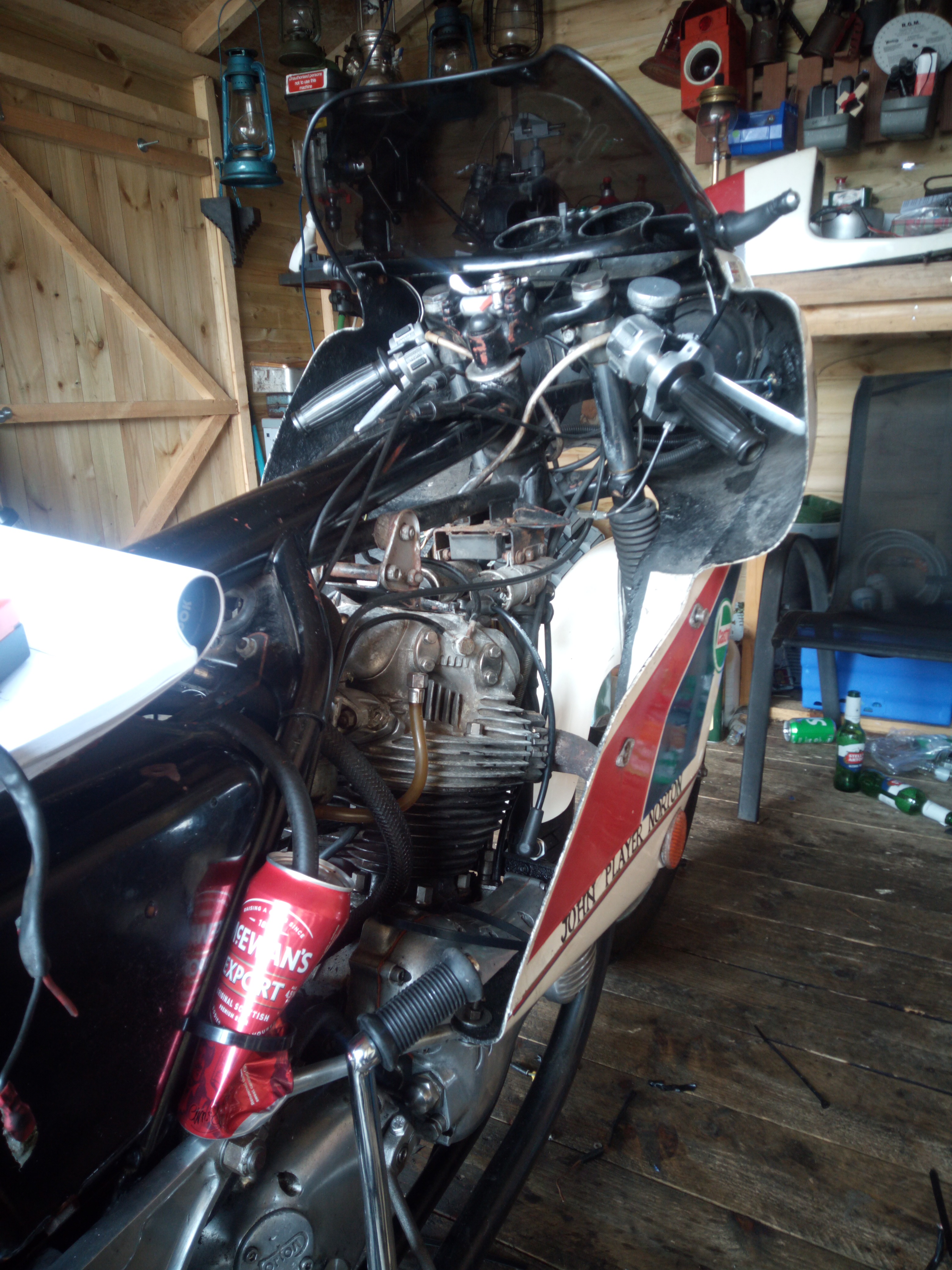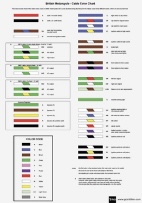After fitting a Tri Spark charging system to my ex Interpol now JPN replica 1972 750 Commando, and seeing the state of the wiring, I decided now's the time to sort it out. Sent away for RGMs wiring loom kit, and although electrics is my weak point, I'm determined to give it a go and be back on the road soon. Does anyone have any advice or tips that'll keep me right?
Grant Tiller is your friend
- Log in to post comments
labels
think ahead as to how to reconnect new loom to all the components: labelling components with wire colours/ positions before disconnecting old loom etc etc, and also routing of wiring through bike frame etc.
and avoiding interference with steering movement etc.
Consider some suitable treatment spray before plugging in new connectors.
- Log in to post comments
Greg Marsh
Has some wiring tips and a sets the standard for restoration.
GME - Norton Wiring (gregmarsh.com)
Regards
Eddie
- Log in to post comments
Invest in the proper…
Invest in the proper crimping tools for the terminals. Al Osborn hates the blue,red,yellow preinsulated terminals and i know what he means, they look totally out of place and crucially they don't have a good grip on the insulation of the wire. They are great for industrial installations and the like but not for vibrating motorbikes.
You have to remember to put the insulating sleeve on the wire before crimping the terminal or invest in the three leg sleeve stretching tool.
Use non-adhesive PVC loom tape to wrap the loom. Avoid the cloth loom tape variety, it attracts all the oil and shite the bike accumulates.
You might consider changing the head steady to the later box type.
- Log in to post comments
bullet connectors
i also prefer Lucas bullet connectors but i solder them on
- Log in to post comments
Head steady
Depending on funds available, I'd go for the third isolastic type as used on the production racers.
- Log in to post comments
I am puzzled over the hatred…
I am puzzled over the hatred of the pre-insulated crimps. If you use the proper crimp tool and the correct procedure, the insulation is gripped. We use them on system that go into all sorts of places including aircraft and helicopters, and even an Atlas vibrates less than a helicopter.
Our crimp tools are calibrated yearly so I suppose if you use a cheap tool and use it for years you might be getting bad crimps.
On the subject of bullet connectors, I think the concept of having to haul on a wire to remove it from the outer bit is horrible. Ok when the system is new and the crimp is good but when it has been in place for years and corroded, you are more likely to pull the wire out or snap it.
You use what you are comfortable with.
For in-line connections I use the Superseal Weatherproof Connectors but I do have the proper ratchet crimp tool.
- Log in to post comments
Are you sure?
Consider some suitable treatment spray before plugging in new connectors. Jan-there is no such thing. Plugging in of connectors, needs to be 'metal to metal' this is the only way electricity conducts. Loom tape- another minefield. Std sticky PVC tape (mostly black) (and the ancient fabric stuff) soon un-winds-rubbish. The manufacturer never used it why should you? RED and Blue nasties-A decent ratchet crimp tool for them might be ok, but if you want your bikes wiring to look like a bad dose of Measels-Cary on. If you are buying a finished loom from any one, then there will NOT be any new connectors or sticky tape needed-will there?? The other major help in a rewire, is to learn the colour scheme. All British vehicles since the early 1960s have used the same colours. Any diagram will give you these colours. Once you have learned them (only 10 basic ones) them you will understand, the wiring-easy.
- Log in to post comments
It may well be possible...
... to make an effective joint with those pre-insulated connectors but I'm with Alan on this - they look hideous especially on an older bike. I do use pre-insulated ring connectors for earthing points etc but pull the insulation off, crimp the bare metal then solder. If not for an earth I also use some black shrink wrap to cover.
Loom tape - I use the non-sticky vinyl stretchy tape which is widely available and finish off the end with a short length of sticky PVC but obly on the loom tape not on the wires.
- Log in to post comments
As I said, use whatever you…
As I said, use whatever you are comfortable with but I will say you should never solder after crimping. The only reason to do that would be if you think you have done a poor quality crimp. A good crimp will create a cold weld gas tight joint. Soldering will add nothing to the joint but will make it more likely to fracture under vibration.
Agee completely about vinyl loom tape but I would prefer to use heat shrink to seal the ends .
- Log in to post comments
Stopped by loose crimped joints
Tom,
Over the years I have been stopped by the side of the road many many more times by loose crimped joints than by broken solder joints. So now all my electrical joints are soldered .
My Rubicon moment came when I visited the Woomera Rocket Range museum in outback South Australia.
All the wiring joints in the rockets and drones and what not were beautifully soldered terminals and connections. From that moment on I made a point of learning to solder properly.
BTW I don't ever remember being stranded by a factory Honda or Yamaha crimped joint.
Don Anson
Melbourne
- Log in to post comments
Pre insulated crimp connectors
Most that you find are made in Asia. Poor quality. Looses grip. Many years ago there was usable ones. Ring crimp connectors are easier to find decent ones. But bullet and spade types, no.
- Log in to post comments
As I don't rely on crimping..
... I use a pair of mole grips to crimp the ring connectors I mentioned prior to soldering. Easy enough to get a tight enough joint but allowing space for the solder to flow.
- Log in to post comments
Well if I only had a pair of…
Well if I only had a pair of mole grips, then I would also solder. But it would only be until I could do a proper job.
- Log in to post comments
on about soldering. i tried…
on about soldering. i tried to solder a thick battery earth wire to add an earth connection from the battery to the chassis on my land rover. i tried everything but it wouldnt solder. later talking to a mate of mine he said you stood no chance. its copper coated aluminium wire.
barry
- Log in to post comments
For the record.....
I have long advocated the F crimp as a 4.7mm bullet. These are the ORIGINAL fittings on the Commando loom. BUT they are no longer made/available. Options-crimp the brass 4.7mm but the tool costs £30 or more! Fine if you are 'in the business' but for a one off job?? This almost means we are back to soldering.
So what is wrong with soldering? If you are working in your garden shed you might not have power. You will burn your fingers! You might burn other wiring on the bike? Soldering leaves a small piece of 'solid' wire with the wire flexing from it-it can break. Adding solder, adds dissimilar metals, along with British weather you encourage corrosion. Soldering is a bit of an art form that neads learning. IF you haven't learnt the crimping is easier to learn.
- Log in to post comments
I am disappointed that the…
I am disappointed that the previous 4.7 F crimp is no longer available, I would have thought that there was sufficient demand to warrant manufacture; I used to crimp them then run solder over the joint, whatever the 'experts' say it has always worked for me over many, many decades.
I have recently bought Durite 4.7 crimp terminals which seem OK. They have the disadvantage that the wire end needs to be covered by some heatshrink tubing after fitting because they are long and bare metal would be exposed when fitted into the tube, however this length of metal does give you something to grip on when separating the joint ie you don't have to pull on the wire. I hope that the supply continues.
- Log in to post comments
Colours
To Al’s point, colour is king!
You can find a handy chart on my site here, that you can download, print out, and stick on your shed wall:
https://granttiller.com/british-motorcycle-cable-color-chart
If you add any of your own cables to support charging/ignition system changes, try to use the right colour cables if you can. It will make your life easier in the future!
- Log in to post comments
Exactly
If you 'make up' the colours as you go along then you wonder where the GRN or is it BLU wire goes on the battery (THERE IS NO GRN OR BLUE ON THE BATTERY). Like all things on the bike (and in life) if you do things casual and without proper thought you suddenly find you have fed the alligator. It turns round and bites you. Same as tools in your garage, when finished put them away! Next time you need them they are in the right place!!
- Log in to post comments





See his collection of wiring diagrams and other useful material at https://granttiller.com.
He also follows the Norton Commando group on Facebook (https://www.facebook.com/groups/10302209470) and will respond to enquiries.
And of course there is our own Al Osborn … (http://www.aoservices.co.uk)